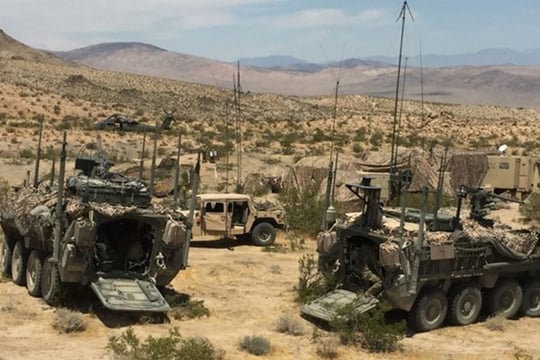Evading Enemy Geolocation – Spectrum Dominance & the US Army Field Manual 3-0 Operations

Part 2
In part 1 of our series, we looked at the new US Army Field Manual 3-0 “Operations” and key to this doctrine is the awareness that units must “account for constant enemy observation,” observation which includes electronic surveillance and SIGINT. We looked at Tactical EMCON Risks that are important for individual radio operators who must communicate under the threat of enemy EW/SIGINT systems. In this part, we look at Evading Enemy Geolocation and how CRFS can help replicate the enemy threat in training. The upcoming Part 3 will wrap up with the Deep Signal SIGINT Risk Group.
Read the reference here.
Evading Geolocation Risk Group
The following are the four FM 3-0 identified risks grouped together around evading geolocation threats. These are specifically important for Tactical Operation Centers, field command posts, expeditionary airfields, supply depots, and other field sites which must communicate under the threat of enemy EW/SIGINT systems.
Dispersing formations and command posts
If a multitude of RF signals are being detected and geolocated in one particular area, the enemy could infer this to be a command post, and target it with indirect fires. Dispersing command posts increases survivability and conceals the unit’s intent. By installing a network of RFeye Nodes and Arrays on an Army training range, potential command posts can be pin-pointed with Time Difference of Arrival (TDOA) and Angle of Arrival (AOA) geolocation. The ability for the enemy to hunt for Command Posts can be replicated and highlight tactical deception successes and/or failures. Save and replay the geolocation “hunt” for an immediate debriefing with the training audience.
Using remote antennas
Placing antennas next to a Command Post is a death sentence. When geolocating a signal using TDOA the area of uncertainty ellipses produced systems might be large, but sufficient for an enemy artillery blast radius to not only take out the antenna, but also the command post. Therefore, students should understand the proper distance that remote antennas should be placed away from Tactical Operation Centers. CRFS TDOA plays the perfect role for the OPFOR, producing ellipses, and showing students how vulnerable they truly are.
Moving command posts and formations
Just because the command post is on the move, doesn’t mean it can’t be tracked. Running 24/7, CRFS Nodes/Arrays can track signals across the PACE plan and highlight communication vulnerabilities while in transit. Track not only ground movement, but CRFS 3D TDOA technology enables Training Ranges to also mimic enemy systems and passively track aircraft and helicopters.
Using directional antennas
Directional antennas are great to prevent omni-directional broadcasts, which could leak into enemy SIGINT range. CRFS Nodes and Arrays can help to show soldiers the benefits of these antennas. Using our mobile Stormcase or a vehicle-mounted Array, instructors could move around the directional antenna to observe sidelobe transmissions and gauge their EMCON effectiveness. Verify the effectiveness in an operational environment, instead of just using the antenna datasheet.
Conclusion
The only way to ensure troops know how to evade being geolocated by the enemy is to carry out realistic training. The training needs to accurately replicate the EW threat troops may be facing. This can be achieved by installing a network of CRFS receivers in and around military training grounds. Signals can be detected, geolocated, and recorded so that troops can experiment with different tactics, technics, and procedures and learn in a realistic training environment. Our solutions are TRL9 and easily procured through multiple DOD contracting pathways, both CONUS and OCONUS.
Zac George
Zac George is the International Business Development Manager for CRFS. He is a former naval Electronic Warfare officer and also has experience in digital decoding. He speaks regularly on EW and spectrum topics globally, and lives in Switzerland.
